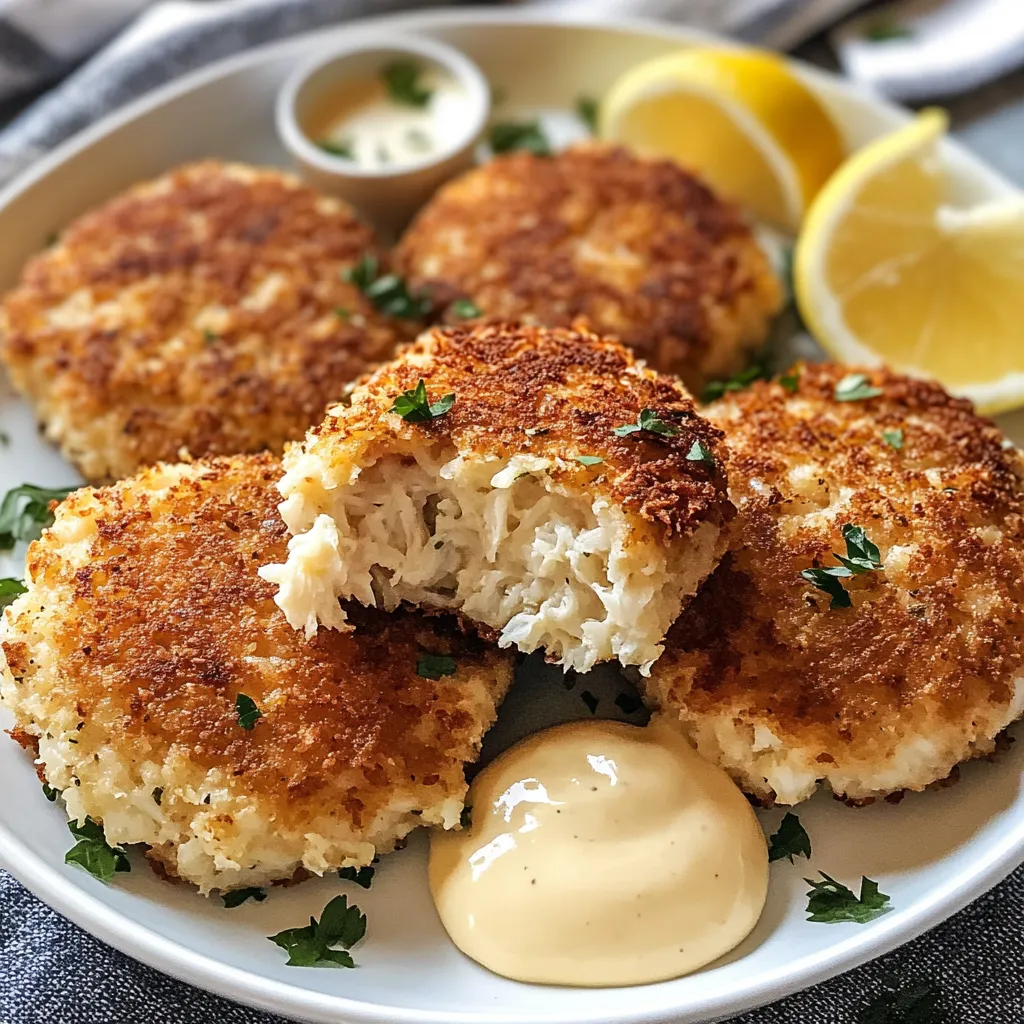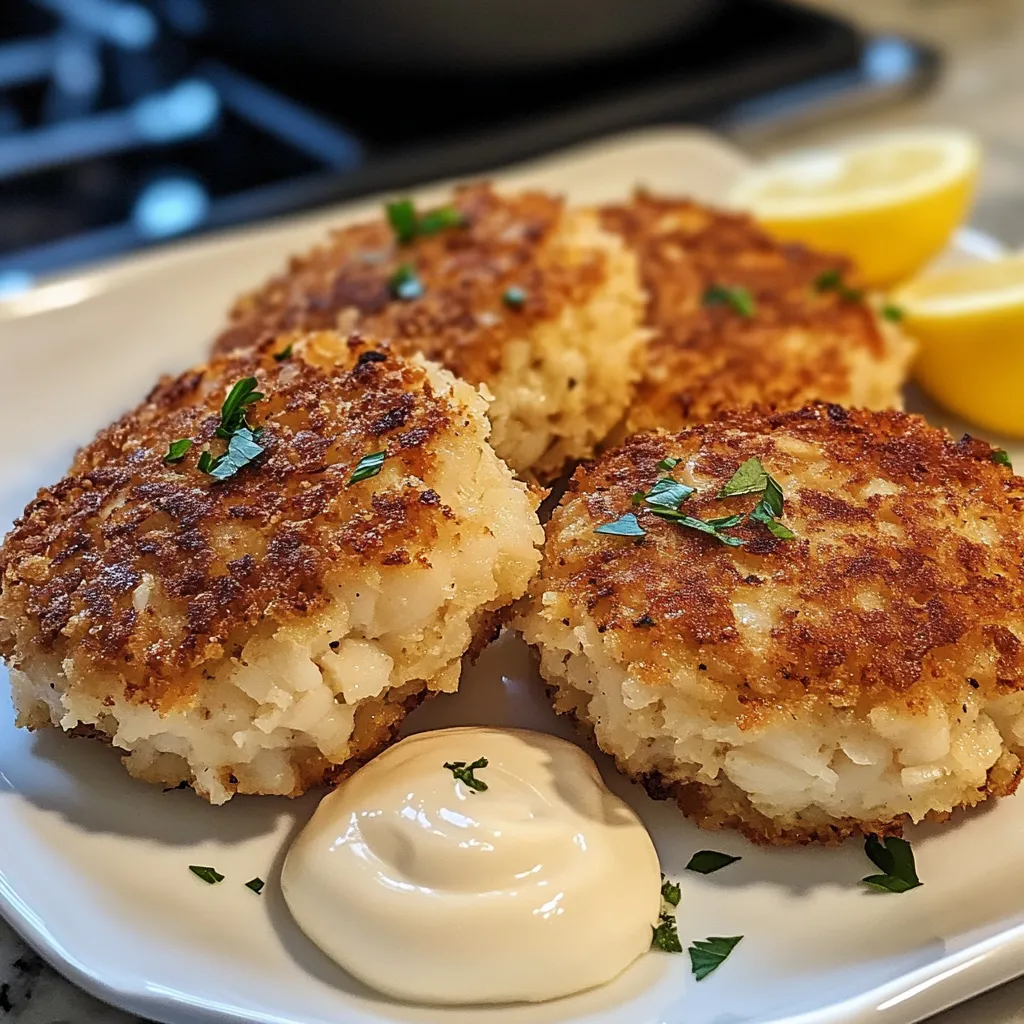 Pin it
Pin it
Golden crispy exteriors give way to tender chunks of sweet crab meat in these authentic Maryland Style Crab Cakes that bring coastal flavors directly to your dinner table. Each savory bite delivers that perfect balance of delicate seafood enhanced with subtle seasonings that complement rather than overwhelm the star ingredient. Creating these treasured seafood patties at home captures the essence of seaside dining with surprisingly simple preparation that transforms ordinary evenings into special occasions.
My introduction to authentic Maryland crab cakes happened during a childhood summer vacation to the Chesapeake Bay where my family rented a small cottage near the water. The elderly woman next door invited us for dinner one evening and served these magnificent golden discs that changed my understanding of seafood forever. She shared her treasured recipe written on a weathered index card, explaining that the secret lay in using minimal ingredients to let the crab shine. Years later, preparing these crab cakes still transports me instantly back to that magical summer evening with waves lapping against the dock and seafood fresh from local waters.
Perfect Components
- Lump crab meat: Forms the foundation of exceptional crab cakes with its sweet flavor and substantial pieces that provide satisfying texture in every bite.
- Fresh breadcrumbs: Create essential structure without overwhelming delicate crab flavor, allowing just enough binding while maintaining moisture throughout cooking.
- Quality mayonnaise: Contributes crucial richness and helps hold ingredients together while promoting beautiful golden exterior during cooking.
- Large fresh egg: Acts as natural binder that unifies all components while adding subtle richness to the overall flavor profile.
- Dijon mustard: Introduces gentle tanginess that balances the richness of crab and mayonnaise without dominating the palate.
- Worcestershire sauce: Delivers complex umami notes that enhance natural sweetness of crabmeat through subtle complementary flavors.
- Old Bay seasoning: Provides authentic Maryland character with its distinctive blend of paprika, celery salt, and spices that perfectly complement seafood.
- Fresh parsley: Brightens both appearance and flavor with herbaceous notes that cut through richness and add visual appeal.
- Lemon juice: Adds essential acidity that balances richness while enhancing natural sweetness of crab through complementary citrus notes.
Preparation Method
- Preparing Crabmeat:
- Begin by carefully inspecting one pound fresh lump crabmeat spread thinly on clean surface, gently removing any shell fragments or cartilage using fingertips rather than tools that might break delicate meat chunks. Transfer cleaned crabmeat to large mixing bowl and add half cup seasoned breadcrumbs with extraordinary gentleness, barely tossing ingredients together to maintain meat integrity.
- Creating Binding Mixture:
- Combine quarter cup mayonnaise with one large beaten egg in separate bowl until completely smooth and uniform. Add one tablespoon each Dijon mustard and finely chopped parsley along with one tablespoon fresh lemon juice squeezed directly into mixture. Introduce one teaspoon Worcestershire sauce and one teaspoon Old Bay seasoning, whisking until perfectly incorporated. Season thoughtfully with salt and freshly ground black pepper, remembering that crabmeat naturally contains some saltiness.
- Forming Perfect Cakes:
- Pour binding mixture over crabmeat and breadcrumb combination, then use rubber spatula or hands with feather-light touch to fold ingredients together using lifting motion rather than stirring. Continue gentle mixing until components just come together with visible crab chunks remaining intact throughout mixture. Allow combined mixture to rest five minutes before shaping into six equal patties approximately three inches diameter and half inch thickness, slightly compressing edges to prevent crumbling during cooking.
- Chilling For Success:
- Arrange formed patties on parchment lined baking sheet and cover loosely with plastic wrap. Refrigerate minimum thirty minutes though preferably two hours to allow flavors to meld completely and binding ingredients to solidify, ensuring cakes maintain shape during cooking process. This resting period proves essential for textural development and flavor integration throughout entire cake.
 Pin it
Pin it
During my culinary school training, our seafood instructor emphasized the importance of temperature when working with crab cakes. Keeping ingredients cold throughout preparation prevents premature binding activation and maintains distinct texture. I discovered this firsthand after rushing through preparation for a dinner party and skipping proper chilling time. The resulting cakes fell apart during cooking, creating expensive crab scramble rather than elegant cakes. This lesson taught me patience pays enormous dividends when working with delicate seafood preparations.
Cooking Excellence
Achieving perfect golden crust while maintaining moist interior requires thoughtful cooking approach. Heat a large heavy-bottomed skillet over medium-high heat until water droplets dance across the surface. Add quarter inch neutral flavored vegetable oil and allow to reach proper temperature indicated by slight shimmer across surface but before smoking point.
Signature Accompaniments
Present crab cakes with lemon wedges and a small ramekin containing a mixture of mayonnaise, splash hot sauce, lemon zest, and chopped fresh dill. For a seasonal option, serve with corn and tomato salad tossed with fresh basil, olive oil, and white wine vinegar. For a brunch twist, replace the English muffin in eggs benedict with a crab cake topped with a poached egg and lemon hollandaise.
Creative Variations
For a southwestern twist, add finely chopped jalapeños and cilantro while replacing Old Bay with cumin and chili powder. Serve with avocado crema for cooling contrast. For a Mediterranean interpretation, include finely minced sun-dried tomatoes and fresh oregano while serving alongside lemon garlic aioli.
Storage Solutions
For advance preparation, form crab cake mixture into patties up to 24 hours before cooking, covering tightly with plastic wrap in the refrigerator. To freeze, arrange uncooked cakes on a baking sheet, freeze until solid, then transfer to an airtight container with parchment between layers. Thaw overnight in the refrigerator before cooking.
 Pin it
Pin it
These Maryland Style Crab Cakes represent coastal cooking at its finest—simple preparation allowing exceptional ingredients to shine through with minimal interference. Through years of perfecting this recipe, I've learned that restraint creates the most memorable results, allowing the natural sweetness of crab to remain center stage. Watching guests close their eyes with pleasure during the first bite provides immeasurable satisfaction knowing you've successfully captured the essence of Chesapeake tradition regardless of geographical location.
Frequently Asked Questions
- → What's the best type of crab meat to use for Maryland crab cakes?
- Lump crab meat or jumbo lump crab meat is ideal for Maryland-style crab cakes. These larger pieces showcase the crab flavor and create the most authentic texture. Avoid claw meat or backfin if possible, as they have a stronger flavor and more shredded texture.
- → Can I bake these crab cakes instead of frying them?
- Yes, you can bake these crab cakes at 375°F for about 15 minutes until golden brown. While frying creates the most authentic crispy exterior, baking is a good option if you're looking for a lighter preparation with less oil.
- → Can I make these crab cakes ahead of time?
- Absolutely! You can form the crab cakes and refrigerate them covered for up to 24 hours before cooking. You can also freeze the uncooked crab cakes on a baking sheet, then transfer to a freezer bag for up to 1 month. Thaw in the refrigerator before cooking.
- → What can I serve with Maryland crab cakes?
- Classic sides include coleslaw, corn on the cob, or a simple green salad. For a more substantial meal, serve with roasted potatoes or rice pilaf. A remoulade or tartar sauce makes a great accompaniment, along with lemon wedges.
- → Why do my crab cakes fall apart when cooking?
- The most common reason is not chilling them before cooking. The 30-minute refrigeration step is crucial as it allows the binding ingredients to set. Also, handle them gently when flipping, and make sure your oil is hot enough before adding the crab cakes to the pan.
